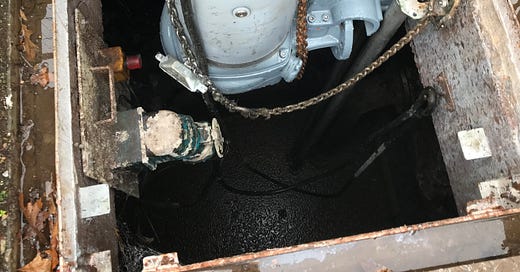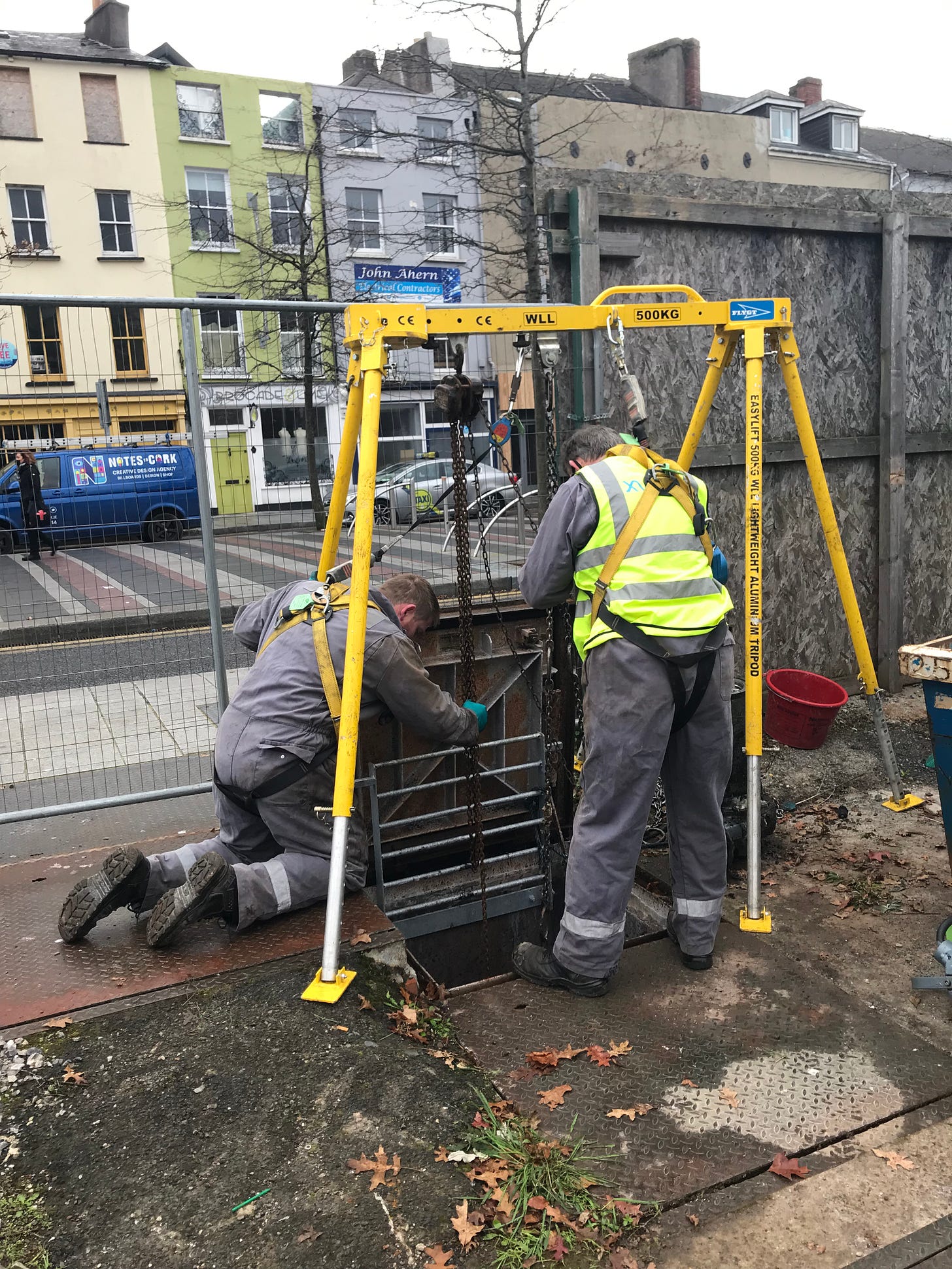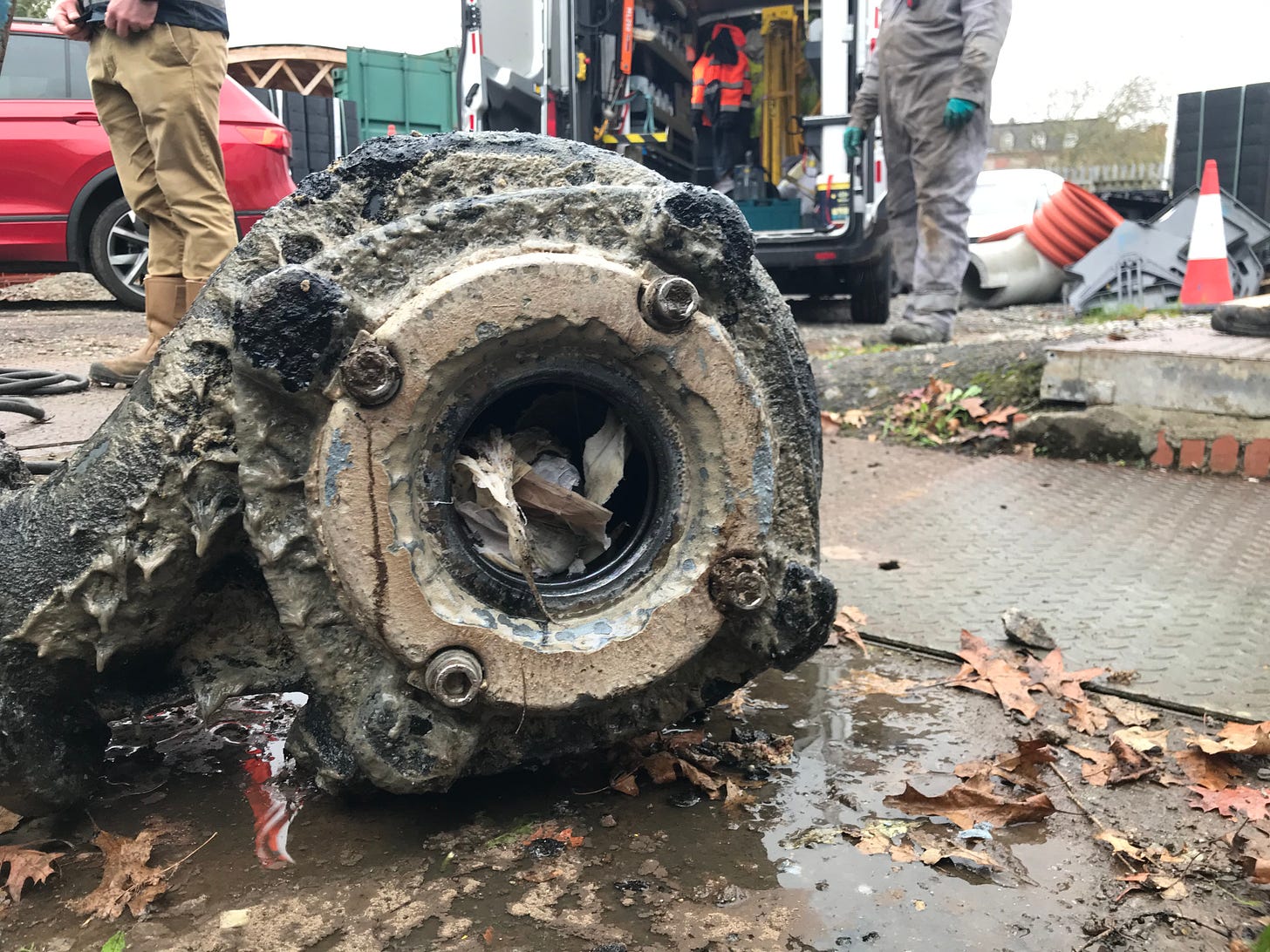Wet wipes, nappies, hair, toys and FOGs: a look inside the sewers of Cork City
Two Cork City Council engineers lift the lid on a pumping station on the Coal Quay - Tripe + Drisheen takes a look inside a city sewer.
Simon Lyons and Tony Donovan refer to the pumping stations spread out across Cork city’s sewerage and drainage network as their children.
As with kids, some of the pumping stations are temperamental, some are troublesome, some warrant constant attention. But, there are also the good ones, the star pupils who carry out their tasks as they are asked.
Both men smile a little when talking about their favourite pumping stations (the good children); they know it’s slightly absurd, but given the amount of time they spend visiting them, thinking about them and taking photos of pumping stations, you come to see why they have favourites.
As Simon navigates the city via pumping stations - “Grand Parade, the one outside Larry Tomkins pub, up on Gilabbey Street, the one up by Forde’s funeral home, the one at Atlantic Pond” - Tony pulls up photos and videos on his phone. He might well have more photos of pumping stations and effluent on his phone than of his own real kids.
The pumping station inside a parcel of council-owned land in front of the Bridewell Garda Station at the bottom of Cornmarket Street is where I meet Simon and Tony on a cold morning this week. Just two weeks before Ellie and I were about 20 metres up the street at the Saturday market selling the first ever print edition of the magazine; I had no idea of the existence of the nearby pumping station beneath the ground - it reaches down about eight metres - which was busy pumping effluent, and a lot else with it, coming from as far back as Sheares Street across North Main Street to the pumping station on the Coal Quay and from there down the quays to the next station outside Larry Tomkins pub.
But that’s the thing about drainage and sewerage systems; most of us give the intricate and ingenious system that uncoils below us very little thought. That is, not until there’s a blockage or a flood and what’s meant to stay below ground, suddenly spews up and induces panic, alarm and condemnation on social media.
I had been following Simon, who like Tony, is also an engineer, on Twitter for a while now, and watching as he pops up on local media and occasionally national media. If you’ve heard him on the radio or read his comments, he’s usually talking about FOGs, those underworld beasts of congealed fats, oils and grease -often referred to as “fatbergs” that block up drains around the world, and which are entirely man, woman and child made.
The other thing Simon talks a lot about are wipes, which along with FOGs, are responsible for so much of what clogs up our drainage network here in Cork.
I had presumed that the pandemic was the cause of the massive increase in wet wipes being flushed down toilets, but as it turns out it’s a problem that’s been building for years. The pandemic just accelerated it.
At one point in our interview I asked what kind of objects they have found in the sewerage and drainage system in Cork? If your answer is “pretty much everything” then give yourself a pat on the back, and also curse humanity at the same time.
That list includes toys, rags, towels, but also nappies - which as they both pointed out expand to the size of balloon once they start absorbing water - and hair which was deposited in far greater amounts as the pandemic turned everyone into stay-at-home hairdressers. You might not think it, and clearly many people didn’t but, the hair from thousands and thousands of heads, well, that too makes its way into fatbergs which help clog up the system.
Tony, the source of all visuals on Cork’s drains, shows me a video of a fatberg being broken up using a lance. It works similar to a power house, except the pressure is turned up so high that the water would cut through your skin. That’s the kind of pressure they need to break up fatbergs and wet wipe mountains which pile up at pumping stations.
Considering that nearly 60% of adults in Ireland pour fats, oil and grease down the sink according to a 2019 survey by An Taisce, they’re probably the kind of videos that should be shown to adults.
I joke with Tony that he should be up on Instagram, considering the content he has.
Before Simon started working with the City Council in 2016 he worked in the private sector; for about eight years he worked in Dubai as a project manager for CH2M Hill, an American engineering firm, on the type and scale of projects that only princes could imagine and finance.
But public service work was an itch that he wanted to scratch and not long after moving back to Cork, he joined the City Council as a senior executive engineer.
Like many, Simon got into public service with good intentions. As he said of his previous job in the Middle East, “you spend a lot of time making money for other people, but are you improving the world all that much?”
“Whereas at least with here (with the City Council) you can come in and say, ‘OK, this is a good thing we are doing and if we’re doing it well, it’s a very good thing we’re doing.’”
“When I came in I had a five year plan: get to grips with what’s going on, fix it, stabilise it, get systems in place, then actually start doing our improvements.”
"We’ve done a bit, but that’s the part I’m not satisfied with,” Simon says of the improvements part.
It’s been - and still is - a big change in culture for Simon, making the switch from the profit-motivated private sector to a public body. “I still have the mindset where I’m like, ‘let’s just go and do it.’”
But, while Simon doesn’t say it, perhaps that’s one of the reasons Cork City Council hired him: to get things done, especially in a city where water is never far away and flooding is commonplace.

A sewerage system is the sum of its whole parts. It’s the drains, the mains, the traps, the covers, the laterals, the pumps, catch basins, sewage treatment plants, the storm drains. And then it’s everything that flows through it.
Looking down into the dark pool of effluent at the pumping station on Cornmarket Street is my first time really coming face to face with the sewerage system that keeps Cork city ticking over every bit as much as the electricity or telecoms network.
The trademark stench from human waste is there when you peer down into the drain, but much of the repair work can be done nowadays outside the drain, from street level. Away from the drain opening there’s very little, if any, smell of effluent. Later on Simon says that the Cornmarket Street pumping station could well be one of his new favourites owing to its condition. It probably helped the pumping station that in the year since Simon and Tony last visited, a lot of nearby businesses were closed or not as busy due to Covid-19 restrictions, and the load of fats, oils and greases was likely reduced.
The reason we’re standing around the drain on Cornmarket Street is Simon, Tony and the two contractors from Xylem are going to service and replace the sump pumps, which have been in place since 2018. There are four pumps at the station, including a storm pump, but usually only one is operational. Simon went into lucid detail about how the pumps work, but suffice to say they have to keep propelling the effluent onward downstream to the treatment plant.
The two contractors from Xylem have erected a crane and pulled out one pump to bring it back to the workshop. They also replaced the cooling jacket on another one of the pumps.




One of the unusual aspects about how Simon operates, especially for a Cork City Council employee, is that he uses social media in a conversational manner to promote what he does. Not in the “influencer” sense: you’d probably have a hard time promoting pumps and sewers as a lifestyle. And bless him, but Simon’s tone is always unfailingly polite. In fact, his Twitter handle is @ThePoliteEng - short for the polite engineer.
But, Simon uses Twitter as a two-way street. He tweets, and listens.
And it works. Twitter users in Cork who know of @ThePoliteEng will regularly slide into his DMs or tag him about the source of a mysterious smell or dodgy discharge, and Simon responds.
Ahead of World Toilet Day earlier this month, Simon posted a data set of the wet wipes collected from the City Council’s Ballinure pumping station, on the south side of the city, dating back over the past three years and broken down into monthly readings.
Simon tells me that after he posted, “There was a guy on Twitter engaging very helpfully, like saying, ‘So, are you saying this is a kilogram per person in the city?’”
“Do you know what? Yeah,” Simon says. That’s a staggering amount, when you factor in that wet wipes are not meant to be discarded in toilets to begin with.
But what he didn’t get into in that Twitter chat was that because the council had invested in new equipment down at Ballinure it was actually wringing water out of the wipes, thereby reducing the overall weight. His point being, the weight figures were actually lower because of the new equipment.
The bigger point here is there are way too many wet wipes being flushed down toilets in Cork. As Simon pointed out in the comments under his tweet: “This graph is saying we flush approx 230 Tonnes (!!!) of wet wipes and other “screenings” down the toilet each year. Scary number, isn’t it!”
Simon is not on a crusade against wet wipes. His own family use them and have a small supply of them. But they go in the bin.
Grand Parade, Friday night, 11 p.m.
To the list of things I did not know about Cork’s main drainage is that just next to the monument on the southern end of Grand Parade lies another pumping station.
Simon and Tony know it well and have been there at all hours of the day and night.
Tony explains how, much like a hospital, the city’s drains and sewers never switch off, and they have to respond to alarms and call outs as they come, and when they come.
“We’ve both been at Grand Parade at 11 o’clock on a Friday night, trying to get into the pump station kiosk behind people either taking a piss up against the door or trying to be your buddy because you look sober and they’re locked.”
“The thing about this job,” Tony says, “is that if you don’t do your job right, people will know very quickly and when you’re doing your job well nobody knows it’s there, but when it goes wrong, it goes wrong.”
The combined sewer overflows (CBOs) are one of the things that can go wrong. There are about 60-70 of them in the city and they’re legacy assets, a holdover from when storm and effluent drains ran side by side.
As Simon explains “it’s a bit Victorian, but it’s still a conventional manner of sewage operations.”
There are times that some of the combined sewer overflow tanks become blocked - again wipes don’t help, Simon says, or they’re struggling with capacity, and the result is discharge leaks into the river.
“A specific example which we don’t hide from is over by Forde’s Funeral Home,” Simon says. “The tank is really struggling because it’s got a huge sewer coming down from upstream and it’s got a small foul outlet and it’s struggling.”
Simon says upgrades are planned for this location, but he does listen and respond as quickly as possible to when it’s brought to his attention, either on Twitter or via the old-fashioned way of calls to City Hall.
“It’s got quite a lot in it”
The rain is coming down softly on the Coal Quay now, and I’m shivering. Like they’re on some kind of fishing expedition, the workers from Xylem have pulled up the pump and it’s lying on its side, about the size of a seal. They’ve opened up the bottom where the propeller is located and we all move around to take a look inside.
Sure enough, it’s clogged with wipes and detritus that should, in an ideal world, not feature in sewer pumps. The pump still works, but it has to work much harder to do its job.
“Those wipes are going to have an energy cost and a maintenance cost. Even if we weren’t here today this would eventually block up,” Simon says, pointing to the station below us. A blockage requires calling the contractors back out again, but on an emergency call-out.
In its budget for 2021, Cork City Council spent just over €226 million on the city and myriad services it provides. Less than 5%, just over €10.1 million, went towards water services, which consists of providing safe water and safely disposing of sewage.
As Simon points out though, the actual spend is much higher, as the City Council budget does not include capital maintenance spend - for example for blasting those fat bergs and wet wipe mountains - which comes from a procurement process through Irish Water, the State-owned utility company founded in 2013.
In fact, while the empty strip of land we’re standing on at the end of Cornmarket Street is owned by the Council, Irish Water own the drains, sewers and assets below ground.
Craziness
According to the latest report from the Environmental Protection Agency (EPA), raw sewage is still being released into 30 cities, towns and villages across Ireland. Ireland has been repeatedly sued by the EU for failing to meet European water standards, and the EPA uses the kind of direct and upbraiding language directed at Irish Water, which you don’t hear or see much of between public bodies in Ireland.
While it sounds like a cliche, Simon thinks everyone, from the agricultural sector to the activists on Twitter in Cork who are outspoken about the biodiversity or proposed rivers works in their area, to local councils should be working together.
Simon lists off a few well-known activists and says that “they all have such an important role to play and for me they need to be listened to.”
“This is definitely my position on things,” he says.
What Simon recognises is that in his own way he too is a campaigner. In his case it’s to try and change behaviour that would lead to less wet wipes and other things that should not be flushed down toilets ending up in the city’s sewers.
He identifies with campaigners in Cork who use social media to highlight their cause.
“The thinking behind putting out the volume of wipes (tweet)…part of me is hoping that people might actually want to know what the month is. Maybe it’s forty people, maybe it’s fifty people.”
“What I realised is people were a bit shocked about what’s coming out. It’s 230 tonnes a year. That’s over 150 cars worth of wipes coming out every year. It’s craziness.”









More than I ever wanted ( but should) know about drains/sewers. I would have passed over it in any other publication but in T&D I just know I need to read it!